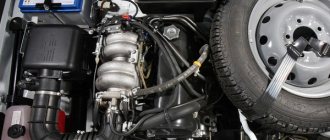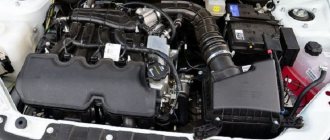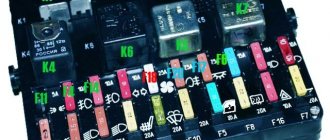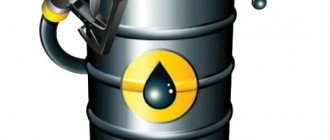09/25/2021 3,638 Lubrication system
Author: Victor
The presence of oil in the transmission lubrication system ensures long-term and uninterrupted operation of the gearbox. Of course, if we are talking about high-quality liquid. Let's look at what characteristics TAD 17 oil has and what disadvantages this product has.
[Hide]
Short description
Transmission oil TAD-17 is made by distilling sulfur category oil. The process removes excess hydrocarbon compounds and foreign impurities from the composition. This approach guarantees the utmost purity of the mineral base.
The formula is supplemented with a complex of highly specialized additives. Additional components increase the performance of the base. The main components are depressant, detergent, and dispersant additives. The result of mixing is the optimization of temperature resistance, increasing the protective characteristics of the liquid.
Features of using lubricant
The high productivity and excellent criteria of the petroleum product have made it very popular in Russia and abroad. The versatility and multifunctionality of the lubricant has been proven in practice.
The main area of use of the TAD-17 is the automotive industry, and more specifically:
- lubrication of important components and systems;
- use for filling in manual transmission;
- lubrication of agricultural equipment;
- applied to individual parts and mechanisms to provide protection during storage;
- sometimes used in the electrical industry.
Even the listed characteristics are enough to note the versatility of the product being described. This fact is confirmed by user reviews. As a plus, motorists also note the low price of the product. TAD-17 can sell for 130-150 rubles/liter, taking into account the region of sale.
Where is TAD-17 used?
The lubricant is designed for servicing manual gearboxes, transmission units, gearboxes, and axles of passenger cars. The oil meets the requirements of light trucks and passenger cars. Suitability for use in agricultural, construction and highly specialized equipment is also noted.
The lubricant effectively protects hypoid, worm, and cylindrical gears.
Application area
The scope of application of TAD-17 oil today is limited not only to gearboxes, axles and transfer cases in domestic vehicles.
The scope of application is generally limited to the GOST class. The lubricant belongs to category TM-5.
This means that it can be used for the following types of transmissions:
- cylindrical spur gears with any tooth profile;
- bevel gears, including those operating at angles other than 90° and with offset axes of rotation;
- chevron gears;
- worm gears;
- cylindrical-conical kinematic pairs;
- hypoid gears operating with high contact loads.
The maximum contact load should not exceed 3000 MPa. This oil is not suitable for more heavily loaded gears, since the protective film will be squeezed out of the contact patch.
manual transmission shafts with various gearing options
Where is TAD-17 poured? The scope of application of this oil is very wide. It is equally suitable for both outdated transmission units and relatively new ones.
The TM-5 class allows it to be successfully used in drive axles and manual transmissions of domestic passenger cars. Many people use this lubricant in winch gearboxes, agricultural and construction equipment attachments, and drives of various stationary equipment.
Before pouring it into the gearbox of a passenger car, it is important to read the operating instructions. This oil is not suitable for some boxes due to possible slippage of synchronizers and their accelerated wear
There are actually a lot of analogues of TAD-17. There is no point in listing them all. It is enough just to understand the designation according to GOST and interpret it in a Western manner.
An analogue of TAD-17I and TAD-17 according to the classification of the American Petroleum Institute are oils of the GL-5 category.
They are not 100% the same in all respects. However, the requirements for key parameters such as viscosity, anti-wear, extreme pressure and anti-foam properties, pour point and types of gears compatible for operation are the same. And this allows the oil in question to be used in units where GL-5 filling is acceptable.
For the SAE classifier, the oil most closely matches the SAE 80W90 standard. For the transmission unit, where the use of lubricant with a viscosity of 80W90 is permissible, TAD-17I or TAD-17 can be used.
In the transmission of imported cars, the oil in question should be used carefully. And it is advisable to change it a little more often
According to manufacturers, the lubricant can operate without problems for 60 thousand kilometers. For boxes of imported cars, it is preferable to reduce the replacement period by 10-20 thousand.
Sometimes you can come across a plan question: which is better, TAD-17 or nigrol? There cannot be an answer to such a question, since it is incorrect. These are two different lubricants. And if we compare it with some other oil, it will most likely be TEP-15.
Nigrol has a much higher kinematic viscosity at operating temperature (from 20 to 35 cSt, depending on whether the winter or summer option is considered). And this already defines nigrol in another area of application.
Main settings
Oil TAD 17 technical characteristics:
| Index | Meaning |
| Kinematic viscosity at +50˚С | 115 |
| Kinematic viscosity at +100 ˚С | 17,5 |
| Viscosity index | 100 |
| Ignition threshold in an open crucible ˚С | +200 |
| Crystallization threshold ˚С | -25 |
| Sulfate ash content | 0,3% |
| Sulfur content % | 2 |
| SAE Compliance | 85W90 |
| Category | GL-5 |
Correct oil change
To prevent damage to your vehicle due to errors when replacing lubricant, you must adhere to several rules:
- Do not mix mineral- and synthetic-based oils;
- it is extremely risky or completely unacceptable to use products of different brands, since they contain different additives that may be incompatible and negatively affect the mechanism;
- Engine oil should be refilled more often, transmission oil less often;
- The timing of changing the transmission fluid is indicated in the operating manual of the car or other unit. If they differ from the above service life of TAD-17, it is recommended to follow the instructions for the vehicle.
TAD-17 is distinguished by fairly high characteristics and is quite applicable for cars of domestic brands, especially in the southern regions of Russia, where there are no severe winters. Reviews from real drivers about this liquid vary, so it cannot be definitely recommended; each car owner has to choose between TAD-17 and imported analogues at his own discretion. In turn, you need to be careful when switching from one brand to another.
It is difficult to indicate the exact chemical composition of the lubricant in question, since manufacturers consider the percentage of additives they use to be their “know-how”, and often recommend “their” oil for certain types of vehicles. Explanation of markings: T – transmission, A – automobile, D – designed for long-term operation, 17 – average value of kinematic viscosity of oil, mm 2 / s at 100 º C. Note that recently this marking is considered obsolete, and is gradually being replaced by a new one , adapted to international requirements. This marking is given in GOST 17479.2-85.
In everyday expressions, Tad-17 lubricant is often called nigrol, although the chemical composition of nigrol is different in many ways: it contains practically no additives, and the actual range of parameters is wider than that of Tad-17.
Performance indicators
High-quality lubricant should not contain mechanical impurities. The concentration of sulfur elements in TAD-17 is 2-2.4 percent. The ash content is three tenths of a percent. The flash point in an open crucible is 200 degrees.
Due to the fact that this petroleum product is classified as a consumable for transmission, special requirements are put forward for its properties. It should significantly reduce the wear of spare parts and prevent them from welding in areas of contact.
Oil liquid TAD-17
The operating period of the unit when using TAD-17 motor oil is greatly increased. This is due to the anti-seize additives contained in the consumables.
According to the SAE classification, which divides oils by viscosity, TAD-17 is classified as 85W-90. This is a heat-resistant petroleum product that significantly reduces the operating noise of the unit. The lubricant is not subject to foaming and provides excellent protection of transmission parts from corrosion. It can be safely poured into both new vehicles and cars with considerable mileage.
TAD-17 oil: technical characteristics, application
TAD 17 oil is optimal for use in manual transmissions. Lubrication allows transfer cases and drive axles to function correctly.
Today, manufacturers provide drivers with a large selection of petroleum products for transmission. Among them, TAD transmission oil is especially popular.
Scope of use
The gearbox contains parts that are in continuous motion. The parts interact with each other. The teeth that the gearbox is equipped with are subject to a lot of pressure. If the lubricant is squeezed out of the contact area of the gears, the teeth may become deformed. In the absence of high-quality motor oil, spare parts wear increases.
When choosing an oil fluid, you need to carefully read its technical characteristics. A high-quality petroleum product forms a thin film on contacting parts, which is very durable. The film effectively protects the unit during its operation.
Nowadays, to lubricate the gearbox, many motorists pour TAD-17 transmission fluid into the unit. This consumable, intended for gearboxes, is considered a universal motor oil. TAD-17 lubricant is poured into the following transmissions:
- conical-spiral;
- cylinder;
- worm;
- hypoid;
- conical
Transmissions carry high loads. The use of lubricating fluid allows the unit to function correctly. Transmission lubricant TAD 17 can be poured into production equipment, machines, tractors.
Composition of automobile oils
It is made by mixing residual elements and distillates. Depressant, phosphorus-sulfur-containing components are added to motor oil. This is precisely why the TAD-17 has such high technical characteristics. Distillates are produced by distilling fuel oil using the fractional method. Anti-foam additives increase the performance of the petroleum product.
TAD-17 complies with GOST 23652-79. It contains a detailed description of the properties of the petroleum product. The viscosity class of the oil is eighteenth. Where does this lubricant fall under the API specification? It is classified as GL-5. The minimum temperature limit is minus twenty-five degrees, the maximum is plus one hundred and forty. Consumables need to be replaced every 80 thousand kilometers.
Performance indicators
High-quality lubricant should not contain mechanical impurities. The concentration of sulfur elements in TAD-17 is 2-2.4 percent. The ash content is three tenths of a percent. The flash point in an open crucible is 200 degrees.
Due to the fact that this petroleum product is classified as a consumable for transmission, special requirements are put forward for its properties. It should significantly reduce the wear of spare parts and prevent them from welding in areas of contact.
Oil liquid TAD-17
The operating period of the unit when using TAD-17 motor oil is greatly increased. This is due to the anti-seize additives contained in the consumables.
According to the SAE classification, which divides oils by viscosity, TAD-17 is classified as 85W-90. This is a heat-resistant petroleum product that significantly reduces the operating noise of the unit. The lubricant is not subject to foaming and provides excellent protection of transmission parts from corrosion. It can be safely poured into both new vehicles and cars with considerable mileage.
Changing transmission oil
The lubricant in the gearbox must be changed at the intervals specified in the operating manual. In addition, it is necessary to take into account the recommendations of the car manufacturer specified in the service book.
Replacing transmission consumables is not carried out as often as changing engine lubricant. You can pour mineral water into the gearbox, but universal or synthetic petroleum products are usually used.
Before pouring new oil, you need to find out what kind of lubricant has already been poured into the transmission unit. However, you can always use imported analogues of TAD-17, which have high performance indicators.
Remember that if a petroleum product begins to smell bad, in other words, stink, it needs to be replaced. A burning smell indicates the exhaustion of the service life. A sharp change in color is also a sign that the consumable needs to be changed. Do not delay replacement until later, otherwise various problems may occur in your car.
motoroil.ru
Technical data
The transmission lubricant meets the regulatory specifications of the Society of Automotive Engineers SAE and is designated 80W 90. The technical characteristics of TAD 17 oil have the following indicators:
- mechanical circulation viscosity at a temperature of 50 °C – 120 mm²/s;
- mechanical circulation viscosity at a temperature of 100 °C – not less than 17.5 mm²/s;
- viscosity index – not less than 100;
- the percentage of sulfate ash does not exceed 0.3%;
- thermostable operating threshold – 200 °C;
- minus pour point – 27 °C.
The TAD 17 transmission lubricant should ideally not contain foreign mechanical impurities. May have small traces of water, phosphorus and sulfur.
The low content of impurities has a beneficial effect on the performance of the lubricant at high temperatures: the oil produces a small amount of soot.
The replacement interval has an exceptional length - a complete replacement of used lubricating fluid is carried out after 80 thousand km of vehicle mileage.
Throughout the entire period of operation, the material does not lose its technical parameters, protecting the transmission device from breakdowns and premature wear every second.
Properties and Features
The lubricant fully complies with the standards of the Russian classification GOST, TM 5-18. Upon detailed analysis of the decoding, the number 5 means that the oil is grouped into category 5. This category of transmission fluids is characterized by extreme pressure properties. Thus, the product is multifunctional. Note that TAD 17 liquid is characterized by viscosity class 18.
According to international classifications, the lubricant is usually classified as API group GL5. The oil ensures the operation of mechanisms and transmission units at temperatures ranging from -25 C. In addition, the lubricant operates at a high temperature limit of up to 140 C.
Gear oil is produced by mixing distillate and residual components of oil refining. Additives with a high content of phosphorus and sulfur compounds, as well as depressants, are added to the finished product.
These additives provide the multifunctional properties of the transmission fluid. Distillate components are obtained by distilling fuel oil into fractions. Due to this, the oil has improved anti-foam characteristics.
Since TAD-17 is a material obtained from distillates and containing a complex of extreme pressure additives, it is replaced in the vehicle’s transmission system upon reaching 60,000-80,000 km.
Working properties of petroleum product
The production criteria for TAD-17i oil are usually specified in accordance with SAE, a community of automotive engineers that integrates lubricant products by viscosity. According to technical documentation according to SAE, the viscosity index of the product is marked with the code 85W-90, and according to the API criterion with the code GL-5. These criteria indicate the operating thermal amplitude of the product. The operating temperature at which the oil can be operated varies from twenty-five degrees minus to one hundred and forty plus.
The manufacturer and consumers of TAD-17 oil note the following functional indicators:
- Increasing the wear resistance of machine parts and components operating under temperature changes and friction.
- High anti-corrosion criteria, which increases the resistance of mechanisms to rust.
- Preventing the formation of nicks on parts and transformations of transport metal structures, which reduces the “sticking” factor of devices.
- Minimizing noise during operation of units.
- Heat resistance and prevention of foaming during intensive vehicle operation.
- High heat dissipation rates during intense friction, which is characterized by high temperatures.
- High lubrication criteria.
TAD-17 oil is used to reliably protect transport units, as well as extend their service life. According to the instructions, the service life of the lubricant is calculated by the mileage of the vehicle, varying from sixty to eighty thousand kilometers. Sold in almost all auto stores in containers of various sizes, it can also be sold on tap.
Advantages
Lubricant TAD 17 has the following operational advantages:
- Increases the lifespan of transmission equipment.
- Provides high wear resistance parameters to all friction elements.
- It prevents the formation of pitting manifestations on metal surfaces, that is, corrosion ulcers.
- Has unsurpassed antioxidant properties.
- It has a stable viscosity, even under enormous circulation overloads.
- Does not foam.
- Cools metal parts and components, removing excess heat to the body.
- Prevents binding and jamming of a variety of gears, from hypoid to bevel and spur gears.
- The products are manufactured strictly according to GOST standards.
- The oil has a universal application structure and is multifunctional.
- Can be used at any time of the year.
Products undergo many tests for suitability and stability and are subject to constant research to ensure compliance with modern requirements in the field of fuel and lubricants operation.
Source










